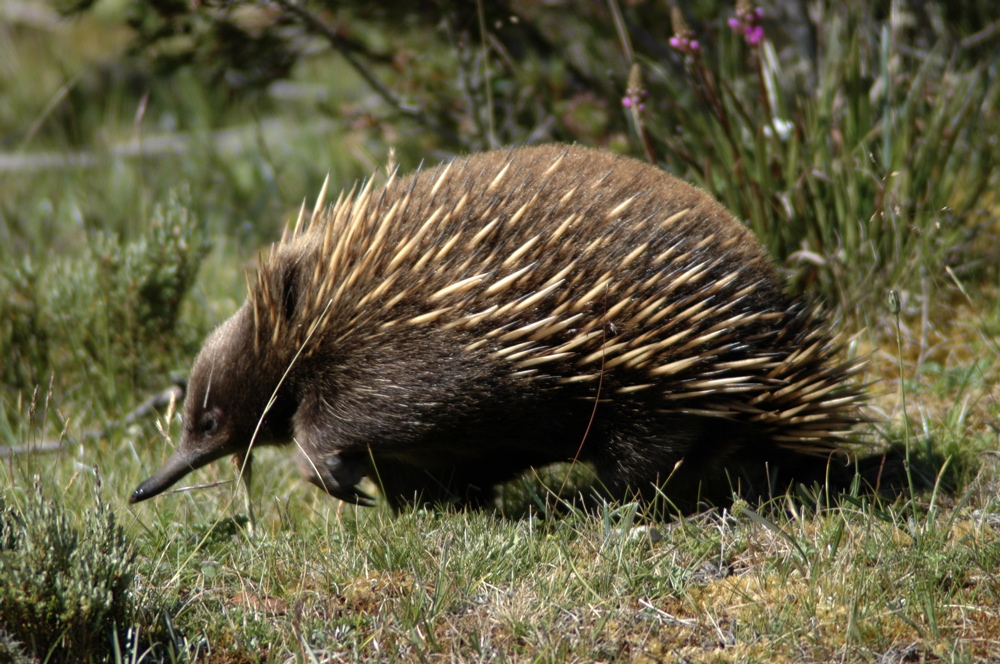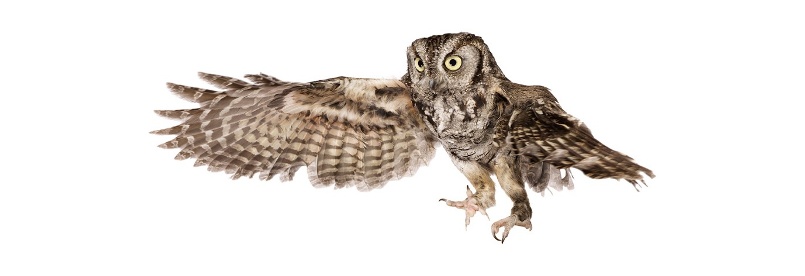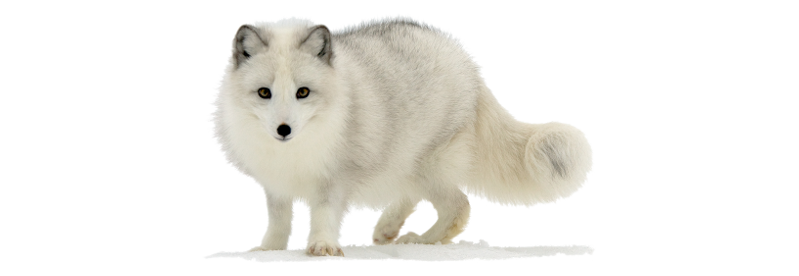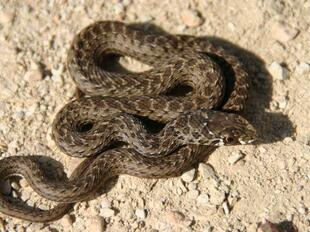
Short-beaked echidna(Tachyglossus aculeatus)
Phylum —chordata
Class — mammalia
Order — monotremata
Family — tachyglossidae
Genus—tachyglossus
Appearance
Short-beaked echidnas are typically 30 to 45 cm (12 to 18 in) in length, with 75 mm (3 in) of snout, and weigh between 2 and 7 kg (4.4 and 15.4 lb). Because the neck is not externally visible, the head and body appear to merge. The earholes are on either side of the head, with no external pinnae. The eyes are small, about 9 mm (0.4 in) in diameter and at the base of the wedge-shaped snout. The nostrils and the mouth are at the distal end of the snout; the mouth cannot open wider than 5 mm (0.2 in). The body of the Short-beaked echidna is, with the exception of the underside, face and legs, covered with cream-colored spines. The spines, which may be up to 50 mm (2 in) long, are modified hairs, mostly made of keratin. Insulation is provided by fur between the spines, which ranges in color from honey to a dark reddish-brown and even black; the underside and short tail are also covered in fur.
Habitat
Short-beaked echidnas are found in Australia, including Tasmania, and Papua New Guinea.
Behavior
Short-beaked echidnas are solitary except during mating time. In the warmer months, they tend to avoid the heat and be nocturnal. At higher elevations, in areas that are more temperate, and in winter, these animals are more diurnal, and will forage around dusk or in the daytime. To some extent they are able to control their temperature, but it is generally lower than other mammals. During cold weather they hibernate for ten days. All their body processes slow down during this time. They can climb and run but they walk with a waddle. Short-beaked echidnas are very powerful. They tear apart rotten logs with their claws, in search of termites, or they dig into ant nests. They nest at sites that are temporary, and their home ranges overlap. Their movements do not depend on territoriality but on food availability.
Diet
The Short-beaked echidna eats ants, termites, worms and grubs.
Reproduction
Short-beaked echidnas are polygynous and in the breeding season a “train” of a number of males may follow one female in the hope to mate with her. June through August is when mating usually occurs. Gestation is for about 23 days, then the female will lay one single soft-shelled egg for incubation in her pouch. After about 10 days the egg hatches and the baby echidna, a “puggle”, will be about 1.5 cm (0.6 inches) long. The puggle stays in its mother’s pouch until its spines develop, at about 3 months old. When puggles are old enough, their mother will go out to feed and leave them in a nursery burrow. Puggles continue to suckle from their mothers until weaning at around 7 months old. They become independent when they are 1-year-old.
In the wild, the Short-beaked echidna has an average lifespan of 10 years, though they can live as long as 40.
In captivity
In captivity, echidnas behave calmly, and increasingly attract the attention of exotic lovers.
The air temperature in the room where the echidna livesshould be 20-30 degrees Celsius. The body temperature of the echidna is 28-32 оС, and the air temperature of 34 degrees can already be life-threatening. This is due to the fact that echidnas do not have sweat glands and cannot cool down on their own. That is why it is very important to install a shallow pool in their enclosure with easy access to it.
When keeping several echidnas in one enclosure, it is necessary to calculate the area so that each echidna had at least 5 square meters, in order to avoid unnecessary fighting between them. Preferably, if the enclosure will have smooth walls without sharp edges and loopholes. The floor shouldn`t have firm surface in order echidnas can dig a hole in it, it should be covered with a sufficient layer of substrate (in quarantine rooms, straw is usually used so that echidnas can burrow into it with their heads). Echidnas are excellent climbers (they easily climb a mesh wall 2 meters high, they would have coped with a stone wall if they had something to cling to). They have very delicate skin on their noses, so if they try to get out through narrow slits, they can get injured. Thanks to strong paws, echidnas are able to move easily heavy objects. When building an enclosure, keep in mind that the echidna is able to climb where you might not expect to see it.
When feeding echidnas, pellets for Nutrazoo insectivores are used. You can use any other granules for insectivorous animals. The pellets are soaked for 1 minute in warm water, add an egg, some honey, bananas or other sweet fruits, sliced slices of poultry heart (raw, not too much, just for the smell), sometimes a few ants. The mixture is thoroughly mixed so that it is slightly liquid. You can add vitamins, especially vitamin B is needed.
The dosage is as follows: for one feeding it is about 3-4 tablespoons. The keeper should watch how quickly they empty the bowl, and if the food is not enough, add more. In the first days, there may be small problems with feeding, echidnas will be in a stressful state and may refuse food. Sometimes it happens that some echidnas take a break from eating. This is normal. Here you need to pay attention to the fact that the echidna would drink water and monitor its weight. Forced feeding is very difficult, as there is a risk of injuring the echidna's mouth.
Echidna needs a lot of water. They store most of it in the body in the form of urine. When you place snide quarantined in a box, it is better not to give them water.The keeper can bathe animals daily. In the appropriate size of the echidna container, you can pour about 5 cm of warm water, sometimes add chamomile and leave the echidna there for about 20 minutes. Then take them out and wipe them with a towel, while checking for accidental abrasions and other external ailments, and then return them to their terrarium.
Despite their spines, it is better to take an echidna without gloves, it will make them se less stressed. The best way to take them is under the stomach, on the sides of the skin, which is perfectly glides on the hand. If suddenly an echidna crawled into a small enclosed space, you should not pull them from there forcibly. Just touch it with your hand, it will start to move away from your hand, and you will drive it to the right place. Echidnas have a keen sense of direction and a good memory, so they will soon get used to their owners and care will become easier.
Short-beaked echidna(Tachyglossus aculeatus)
Phylum —chordata
Class — mammalia
Order — monotremata
Family — tachyglossidae
Genus—tachyglossus
Appearance
Short-beaked echidnas are typically 30 to 45 cm (12 to 18 in) in length, with 75 mm (3 in) of snout, and weigh between 2 and 7 kg (4.4 and 15.4 lb). Because the neck is not externally visible, the head and body appear to merge. The earholes are on either side of the head, with no external pinnae. The eyes are small, about 9 mm (0.4 in) in diameter and at the base of the wedge-shaped snout. The nostrils and the mouth are at the distal end of the snout; the mouth cannot open wider than 5 mm (0.2 in). The body of the Short-beaked echidna is, with the exception of the underside, face and legs, covered with cream-colored spines. The spines, which may be up to 50 mm (2 in) long, are modified hairs, mostly made of keratin. Insulation is provided by fur between the spines, which ranges in color from honey to a dark reddish-brown and even black; the underside and short tail are also covered in fur.
Habitat
Short-beaked echidnas are found in Australia, including Tasmania, and Papua New Guinea.
Behavior
Short-beaked echidnas are solitary except during mating time. In the warmer months, they tend to avoid the heat and be nocturnal. At higher elevations, in areas that are more temperate, and in winter, these animals are more diurnal, and will forage around dusk or in the daytime. To some extent they are able to control their temperature, but it is generally lower than other mammals. During cold weather they hibernate for ten days. All their body processes slow down during this time. They can climb and run but they walk with a waddle. Short-beaked echidnas are very powerful. They tear apart rotten logs with their claws, in search of termites, or they dig into ant nests. They nest at sites that are temporary, and their home ranges overlap. Their movements do not depend on territoriality but on food availability.
Diet
The Short-beaked echidna eats ants, termites, worms and grubs.
Reproduction
Short-beaked echidnas are polygynous and in the breeding season a “train” of a number of males may follow one female in the hope to mate with her. June through August is when mating usually occurs. Gestation is for about 23 days, then the female will lay one single soft-shelled egg for incubation in her pouch. After about 10 days the egg hatches and the baby echidna, a “puggle”, will be about 1.5 cm (0.6 inches) long. The puggle stays in its mother’s pouch until its spines develop, at about 3 months old. When puggles are old enough, their mother will go out to feed and leave them in a nursery burrow. Puggles continue to suckle from their mothers until weaning at around 7 months old. They become independent when they are 1-year-old.
In the wild, the Short-beaked echidna has an average lifespan of 10 years, though they can live as long as 40.
In captivity
In captivity, echidnas behave calmly, and increasingly attract the attention of exotic lovers.
The air temperature in the room where the echidna livesshould be 20-30 degrees Celsius. The body temperature of the echidna is 28-32 оС, and the air temperature of 34 degrees can already be life-threatening. This is due to the fact that echidnas do not have sweat glands and cannot cool down on their own. That is why it is very important to install a shallow pool in their enclosure with easy access to it.
When keeping several echidnas in one enclosure, it is necessary to calculate the area so that each echidna had at least 5 square meters, in order to avoid unnecessary fighting between them. Preferably, if the enclosure will have smooth walls without sharp edges and loopholes. The floor shouldn`t have firm surface in order echidnas can dig a hole in it, it should be covered with a sufficient layer of substrate (in quarantine rooms, straw is usually used so that echidnas can burrow into it with their heads). Echidnas are excellent climbers (they easily climb a mesh wall 2 meters high, they would have coped with a stone wall if they had something to cling to). They have very delicate skin on their noses, so if they try to get out through narrow slits, they can get injured. Thanks to strong paws, echidnas are able to move easily heavy objects. When building an enclosure, keep in mind that the echidna is able to climb where you might not expect to see it.
When feeding echidnas, pellets for Nutrazoo insectivores are used. You can use any other granules for insectivorous animals. The pellets are soaked for 1 minute in warm water, add an egg, some honey, bananas or other sweet fruits, sliced slices of poultry heart (raw, not too much, just for the smell), sometimes a few ants. The mixture is thoroughly mixed so that it is slightly liquid. You can add vitamins, especially vitamin B is needed.
The dosage is as follows: for one feeding it is about 3-4 tablespoons. The keeper should watch how quickly they empty the bowl, and if the food is not enough, add more. In the first days, there may be small problems with feeding, echidnas will be in a stressful state and may refuse food. Sometimes it happens that some echidnas take a break from eating. This is normal. Here you need to pay attention to the fact that the echidna would drink water and monitor its weight. Forced feeding is very difficult, as there is a risk of injuring the echidna's mouth.
Echidna needs a lot of water. They store most of it in the body in the form of urine. When you place snide quarantined in a box, it is better not to give them water.The keeper can bathe animals daily. In the appropriate size of the echidna container, you can pour about 5 cm of warm water, sometimes add chamomile and leave the echidna there for about 20 minutes. Then take them out and wipe them with a towel, while checking for accidental abrasions and other external ailments, and then return them to their terrarium.
Despite their spines, it is better to take an echidna without gloves, it will make them se less stressed. The best way to take them is under the stomach, on the sides of the skin, which is perfectly glides on the hand. If suddenly an echidna crawled into a small enclosed space, you should not pull them from there forcibly. Just touch it with your hand, it will start to move away from your hand, and you will drive it to the right place. Echidnas have a keen sense of direction and a good memory, so they will soon get used to their owners and care will become easier.
 Russian
Russian
 English
English
























